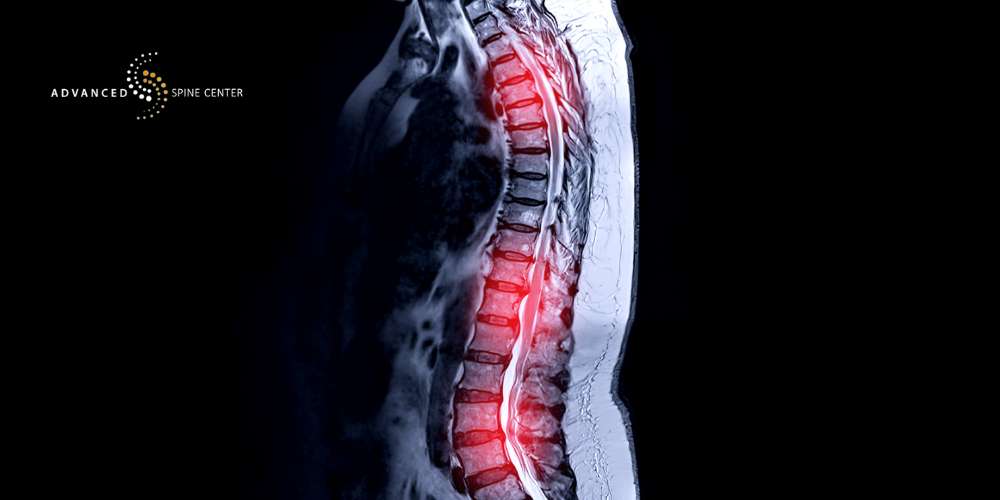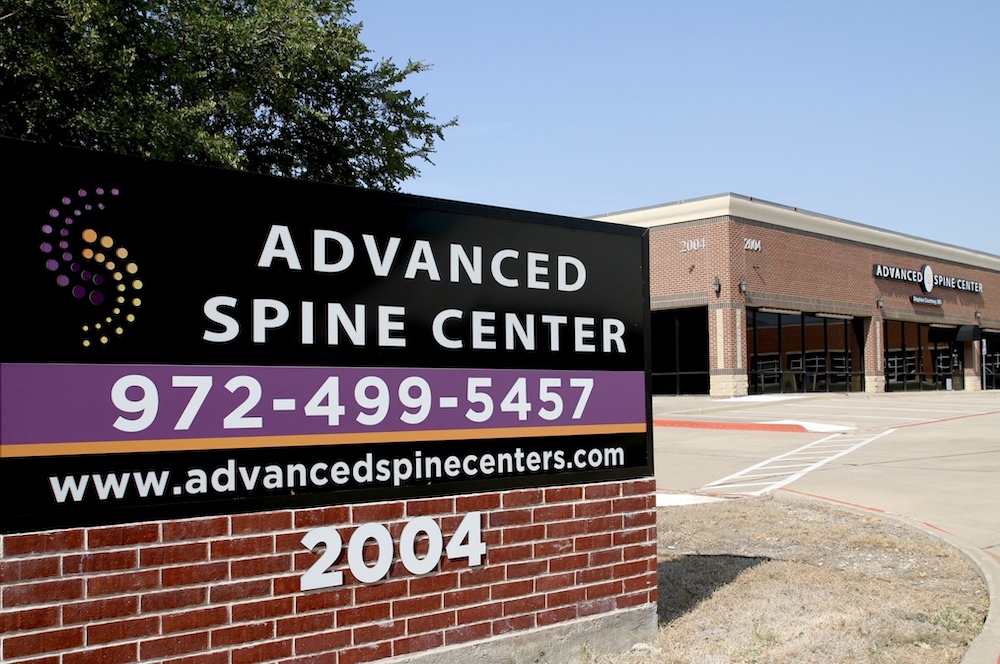Specialties

If you or someone you love is experiencing neck pain, numbness, muscle weakness, or difficulty walking, it may be time to consider myelopathy treatment in Plano, TX, at Advanced Spine Center. When the spinal canal narrows and puts pressure on the spinal cord, it can lead to serious complications, including cervical spondylotic myelopathy and long-term spinal cord involvement.
Led by Dr. Stephen Courtney, our team uses advanced diagnostic tools to assess severity and recommend the most effective treatment options, whether through conservative treatment or surgical procedures such as an anterior or posterior approach. Contact Advanced Spine Center at (972) 499-5457 or complete our online contact form to learn how we can help relieve symptoms and protect your spinal health.
What is Myelopathy?
Myelopathy is a condition caused by spinal cord compression or damage to the spinal cord, often resulting from degenerative changes in the spine. It can affect different areas of the spinal cord, but is most commonly seen in the cervical spine.
When the spinal canal narrows due to conditions like spinal stenosis, herniated disks, or bone spurs, it can lead to cord compression and disrupt the way signals travel between the brain and the rest of the body. This disruption may lead to a wide range of symptoms, including numbness, muscle weakness, coordination issues, and difficulty walking.
Myelopathy vs. Radiculopathy
Myelopathy and radiculopathy both involve problems within the spine, but they affect different parts of the nervous system. Myelopathy refers to compression or damage to the spinal cord itself, often due to spinal stenosis, a herniated disk, or degenerative changes in the cervical spine. This can cause symptoms such as loss of balance, lower extremity weakness, coordination issues, and other signs of spinal cord involvement.
Radiculopathy, on the other hand, occurs when a spinal nerve root is compressed or irritated, typically causing pain, numbness, or muscle weakness that radiates along a specific nerve path, often into the arms or legs.
While myelopathy tends to produce more widespread and serious effects due to spinal cord compression, radiculopathy is usually more localized. Proper testing, including a physical exam and imaging, is necessary to diagnose myelopathy or radiculopathy and recommend the best treatment.
Types of Myelopathy

Myelopathy can affect different regions of the spine depending on where the spinal cord compression occurs. The location of the pressure plays a key role in determining which symptoms appear and how severe they become. Degenerative changes, spinal stenosis, herniated disks, and bone spurs can all lead to varying forms of myelopathy.
Cervical Myelopathy
Cervical myelopathy happens when the cervical spinal cord becomes compressed. As the spinal canal narrows, it can squeeze the spinal cord and cause a range of symptoms, including neck pain, numbness, lower extremity weakness, loss of balance, and coordination issues.
Without proper treatment, cervical myelopathy can lead to severe complications involving permanent spinal cord injury. Treatment options depend on the severity of symptoms and may involve conservative treatment like physical therapy or surgical management using either an anterior or posterior approach to relieve pressure and protect overall health.
Cervical Spondylotic Myelopathy
Cervical spondylotic myelopathy is the most common type of myelopathy in adults over age 50 and is caused by age-related degenerative changes in the cervical spine. As the soft tissues and disks wear down over time, bone spurs and thickened ligaments can form, leading to spinal cord compression.
This condition can result in myelopathy symptoms such as neck pain, numbness, muscle weakness, difficulty walking, and coordination issues. In severe cases, cervical spondylotic myelopathy may cause significant spinal cord involvement and nerve damage if left untreated.
Thoracic Myelopathy
Thoracic myelopathy occurs when the spinal cord is compressed in the thoracic spine, the middle section of the back. Although less common than cervical myelopathy, it can still cause serious symptoms such as numbness, lower extremity weakness, loss of balance, and difficulty walking.
This type of myelopathy is often linked to spinal stenosis, herniated disks, bone spurs, or other degenerative changes that narrow the spinal canal and lead to spinal cord involvement. In severe cases, thoracic myelopathy can cause significant coordination issues and even bowel or bladder problems.
Lumbar Myelopathy
Lumbar myelopathy is rare because the spinal cord usually ends at the upper part of the lumbar spine. However, when it occurs, it is typically due to severe spinal stenosis or other abnormalities that cause compression near the end of the spinal cord.
Symptoms of lumbar myelopathy can include lower extremity weakness, numbness, loss of balance, coordination issues, and severe pain in the lower back or legs. In some cases, lumbar puncture tests or imaging studies are needed to diagnose myelopathy and determine the extent of spinal cord involvement.
Myelopathy Symptoms

Myelopathy symptoms can vary depending on the location and severity of spinal cord compression, but several signs are commonly reported. Patients may experience neck pain, numbness, muscle weakness, lower extremity weakness, and difficulty walking.
Coordination issues, loss of balance, and problems with fine motor skills, such as buttoning a shirt or writing, are also frequent complaints. In severe cases, spinal cord involvement can lead to more serious problems like bladder or bowel dysfunction.
Recognizing the symptoms of myelopathy early is important because severe symptoms can worsen over time and lead to permanent spinal cord injury. If you notice any of these signs, it is important to schedule an evaluation at Advanced Spine Center to diagnose myelopathy and discuss treatment options that can relieve symptoms and protect your overall health.
What Causes Myelopathy?
Myelopathy is most often caused by spinal cord compression resulting from degenerative changes in the spine. Conditions like spinal stenosis, herniated disks, and bone spurs can narrow the spinal canal and put pressure on the spinal cord. Degenerative cervical issues are a leading cause, especially in older adults, but injuries, tumors, or inflammatory diseases can also lead to myelopathy.
Risk Factors for Developing Myelopathy
Several risk factors can increase the chances of developing myelopathy, especially as the spine changes over time. Aging is one of the most common factors, as degenerative changes in the cervical spine, such as spinal stenosis, bone spurs, and herniated disks, often develop with age.
Individuals with a history of spinal cord injury, arthritis, or congenital conditions that narrow the spinal canal are also at higher risk. Other risk factors include repetitive spine strain, poor posture, and certain inflammatory diseases that affect soft tissue and joints.
Diagnosing Myelopathy at Advanced Spine Center

Diagnosing myelopathy at Advanced Spine Center begins with a thorough review of your medical history and a physical exam to evaluate symptoms such as muscle weakness, numbness, coordination issues, and difficulty walking. Our team looks for signs of spinal cord involvement and assesses the severity of any spinal cord compression.
Imaging studies such as MRI or CT scans are typically used to identify conditions like spinal stenosis, herniated disks, bone spurs, or other degenerative changes affecting the spinal canal. In some cases, additional testing, such as a lumbar puncture, may be used to rule out other causes or confirm spinal cord injury.
By combining advanced diagnostic tools with a detailed clinical evaluation, we can diagnose myelopathy accurately and recommend the best treatment plan to relieve symptoms and prevent further complications.
Nonsurgical Treatment Options for Myelopathy
Nonsurgical treatment options for myelopathy may be recommended for patients with mild to moderate symptoms or those who are not ideal candidates for surgery due to age or overall health. At Advanced Spine Center, conservative treatment plans are designed to relieve symptoms and improve quality of life without surgery.
These nonsurgical treatments may include physical therapy to strengthen muscles and improve coordination, anti-inflammatory medications to reduce pain and swelling, and the use of a neck brace to limit motion and support the cervical spine. Nonsurgical management can also involve activity modification and regular monitoring to assess for any signs of progression.
While nonsurgical treatment may not reverse spinal cord compression, it can help manage symptoms and slow the progression of spinal cord involvement in certain cases.
Myelopathy Surgical Treatments in Plano, TX
At Advanced Spine Center, myelopathy surgical treatments focus on relieving spinal cord compression, restoring stability, and preventing further damage to the spinal cord. Treatment options may include an anterior approach, such as anterior cervical discectomy and fusion to remove herniated disks or bone spurs, or a posterior approach, like posterior laminectomy, to create more space within the spinal canal. In more severe cases, a cervical corpectomy may be needed to remove a damaged vertebral body and relieve pressure.
Each surgical plan is based on a careful review of the patient’s symptoms, medical history, and imaging studies to recommend the best treatment option. Our goal is to relieve symptoms such as numbness, lower extremity weakness, neck pain, and difficulty walking while protecting the overall function of the spinal cord.
If you are considering surgery to treat myelopathy, our team at Advanced Spine Center can help determine which surgical procedure is the best option for you. To schedule a consultation for a laminectomy in Plano, TX, or other surgical procedure that treats myelopathy, call (972) 499-5457 today.
Myelopathy Surgery Recovery
Following a myelopathy surgery, the recovery timeline depends on the severity of spinal cord compression before surgery, the specific surgical procedure performed, and the patient’s overall health. Most patients stay in the hospital for a short period to monitor and manage pain before starting a personalized rehabilitation plan.
Physical therapy is often recommended to help relieve symptoms, improve coordination, and rebuild muscle strength. Some patients may be asked to wear a neck brace temporarily to support the cervical spine as it heals.
Improvement in symptoms such as numbness, lower extremity weakness, and difficulty walking may be seen within weeks, although full recovery can take several months. Following post-surgical instructions carefully helps reduce the risk of complications and leads to better long-term results.
Myelopathy FAQs
Why Does Cervical Myelopathy Affect the Legs?
Cervical myelopathy affects the legs because the cervical spinal cord carries nerve signals that control movement and sensation throughout the entire body, including the lower extremities. When compression occurs in the cervical spine, it disrupts these signals, leading to symptoms such as lower extremity weakness, difficulty walking, and loss of balance.
Can Myelopathy Symptoms Improve Without Surgery?
In some cases, myelopathy symptoms can improve without surgery through nonsurgical treatment options like physical therapy, anti-inflammatory medications, and the use of a neck brace. However, if spinal cord compression is severe or symptoms continue to worsen, surgical treatment may be needed to relieve pressure and prevent permanent spinal cord injury.
When are Surgical Procedures Recommended for Myelopathy?
Surgical procedures are typically recommended for myelopathy when symptoms are severe, progressive, or when there is significant spinal cord compression that threatens long-term function. Surgery may also be advised if nonsurgical treatment options fail to relieve symptoms such as numbness, lower extremity weakness, loss of balance, or difficulty walking.
Contact Advanced Spine Center for Myelopathy Treatments in Plano, TX

If you are noticing symptoms like neck pain, numbness, muscle weakness, or loss of balance, Advanced Spine Center is here to help. Our experienced team will evaluate your condition, explain your treatment options, and recommend the best approach to relieve pressure on your spinal cord and improve your quality of life.
Contact Advanced Spine Center in Plano, TX, today at (972) 499-5457 to schedule an appointment and take the first step toward effective myelopathy treatment.


